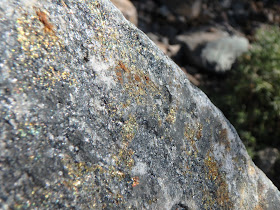Nature is the real boss here.
Monday's snow turned the surrounding topsoil to mud, halting my finishing the last rock bits. But that's OK, because this fall was an opportune if unplanned time to jam in the first plants!
Yeah, "jamming" is what we young people will call planting from now on.
That's my jam.
The back bit, hidden against the building, will sit undone till next spring, but you'll see the little childsplay-river rivulet back there where I tested the grade and drainage so that snowmelt crashing off the glass roof can drain over the surface of a potentially frozen soil and escape from around the crevice garden. You've gotta plan for this stuff unless your bad dreams aren't made of boulders, ice, snow, and cracking, like a season finale of Game of Thrones.
One of the great fortunes of this project is having access to not just gravel made out of the very stone we used, but different screened sizes, too. So we did that thing which makes quarries and rock-shops raised their eyebrows: buy several different sizes and let them get mixed in the truck.
A bit of fun- they sort themselves again in a wheelbarrow if tipped just right.
As per my usual approach, the whole garden got topressed in an inch or two thick of 1/4" screen gravel (easy to dig into), which gives the look of a very steep and convoluted parking lot in-between all the big stones. But that is what the odd sized gravel is for: "Nature-ifying." (in the spirit of stupid invented words)
An open-soil expanse to give foil to and break up the solid-stone areas.
Let's have a look at the progress of Nature-ifying an area of flat, even gravel:
Flat, even gravel with a few outliers from the solid-stone areas.
Larger (1" - 1.5", or 2.5 - 4cm) gravel added unevenly: heavy in some areas, absent in others.
Stepped on. The faces of each gravel piece rock looks up now, which often happens on its own after a good winter. But the keen eye will see there is still a gap in size between the softball-sized chunks and the largest gravel.
So we throw in just a few, literally 3, which bridge that size.
Bang, done: "Naturified." Now we have to patiently let the plants grow up, for which we have no Millennial-generation shortcut.
Have I mentioned the pyrite, or "fool's gold." which is very visible on some of the stone's surfaces? It's a conspiracy between sulfur and iron.
I learned a lot from the master gardeners: what they were growing in their gardens (and how it behaves), which will inform what plants I try next spring.
And I was also told what I'd sought to no avail- the name of this geologic member-
"Sherman Granite."
Bare-rooting is the only way to plant manzanitas. And in fall, too.
Beautifully grown by Kelly Grummons, this is our favorite, the Greenleaf Manzanita, Arctostaphylos patula, which certainly must occur in a certain rare corner of Wyoming. This particular strain is a 2011 Utah collection by the Boulder, CO plantsman Allen Taylor.
As I wrote earlier- here is how to know you are planting at the ideal time. Roots in active growth! Look at'm grow! They are preserved by a patient, gentle washing in bucket of water to get the potting mix mostly off. We won't cry if there is a little bit of perlite clinging in still.
They don't look too bad against that stone. I put them in this "ravine" to protect them, while young, from wind, and I'm curious how far out they will grow once settled in. I've seen them hunkered down behind rocks in nature when on windy ridges. They are not just here because I love manzanitas. Well, in part. Actually, they lend a good, rich green to the garden, visible from a distance. The sexy sexy rutile-red stems against the blue-purple granite is just a bonus.
Rhamnus pumila, a dwarf alpine buckthorn from the Alps, is promising for some amazing gnarled woody structure as well as, again, a supply of rich green, very visible at a distance (and useful aesthetically in this way). I also feel that because it is deciduous, it will not suffer from the drying winter winds. I'll let you know.
It's one of my favorite plants going in. There are three, and long-term hopes are that there will be both a boy and girl in that mix so that future mad plant fiends will be able to collect the fruit and grow more of them. Tell me: is there any real reason not to get plant-randy by a tiny tree which espaliers itself in limestone crevices? Ooof!
Well, there is a bit of warm fall weather ahead, perhaps enough to let everything root in well before proper cold and winter. I look forward to coming back and seeing you all in spring and finishing the garden.


















No comments:
Post a Comment